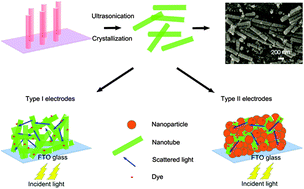Assembly of a high-scattering photoelectrode using a hybrid nano-TiO2 paste†
Abstract
The nanostructure architecture of photoanodes is a key factor in limiting the performance of dye-sensitized solar cells. In this study, TiO2 nanotube (NT) powders were fabricated by the anodic growth of NT arrays on titanium foils followed by ultrasonic dispersion of the obtained NTs. The NTs were collected, annealed and then coated onto transparent conductive substrates to form pure NT photoanodes. The crystallinity of the NTs was optimized at a high annealing temperature. The highly crystallized NT powders were then incorporated into TiO2 nanoparticle (NP) pastes to form NT–NP hybrid pastes; hybrid photoanodes were thus obtained. The embedded NTs served as a light-scattering component to trap the incident light inside the dye-sensitized TiO2 films, leading to a significant enhancement in light absorption. By adjusting the weight ratio of the NT–NP hybrid pastes, the scattering effect could be optimized. The hybrid photoanode with the optimum film composition (50 wt% NT) gave the highest solar cell efficiency of 6.00% due to the simultaneous improvement in light scattering, dye anchoring and NT crystallinity. This fabrication strategy is simple, efficient, economical and suitable for use in large-scale production.


 Please wait while we load your content...
Please wait while we load your content...